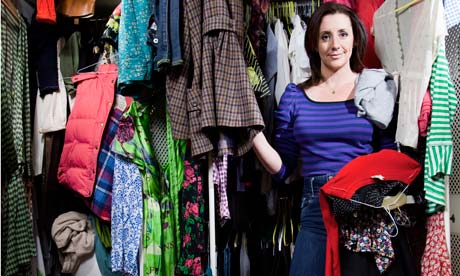Every morning when I wake up I am confronted by my
fashion history. Mistakes, corrections, good buys, bad buys, comfort buys, drunk buys: they refuse to go away. This is because my wardrobe is opposite my bed, and the door, like a broken zipper, will no longer pull across to hide the tale of excess. In the cold light of day many of the micro trends I've "invested in" – T-shirts with chains, a one-shouldered jumpsuit, and other designer lookalike items – merge to form a type of sartorial wasteland.
My collection is testament to the extraordinary way we now consume clothes. And I don't have to come around to your house and have a look to make a good guess at what you've got in your cupboards, because over the past decade and a half not only have we bought more at increasing speed, but our tastes have become increasingly homogenised. If your clothing journey follows not only fashion trends but consumer trends, you'll find you have only a small amount of formal wear and a similarly small amount of office wear compared to a decade ago. Instead, you'll have hangers and shelves and drawers full of home and leisurewear, and there's likely to be evidence that you've bought into some strange new apparel categories, such as luxe loungewear. The most ubiquitous item is likely to be the T-shirt, along with its close relation the skinny-ribbed vest.
You now demand roughly four times the number of clothes you would have in 1980. You will spend at least £625 a year on clothes – but remember that's just the average. And you are getting a lot of bang for your buck. In one year you'll accumulate in the region of 28kg of clothing – adding up to an estimated 1.72m tonnes of brand-new fashion being consumed on an annual basis in the UK. But the really arresting thing is that almost the same quantity of fashion that you buy will end up being dumped prematurely in the rubbish bin.
Our ways of buying fashion and our relationship with the garments we own started changing in the mid-1980s. By 2005, academic research was picking up on the salient points. Louise R Morgan and Grete Birtwistle set up eight consumer focus groups, surveying 71 women about their purchasing habits. Nearly all confessed to spending more than they used to, but what's really notable is that they had absolutely no plan as to how long they intended to keep any of their purchases. They also admitted that when "cheap" fashion tore or became stained, its likely destination was not the washbasket, but the rubbish bin. The old way of buying clothes, in harmony with one's income and the seasons, the way people wore, washed carefully and darned, has nothing in common with the way we now consume.
Perhaps that mindset explains why a fashion industry commentator watched in horror as she saw one satisfied customer emerge from Primark's flagship Oxford Circus store with six or seven brown paper bags full of clothes. It was raining heavily, and as the young woman proceeded down Oxford Street one of them broke around the handles and folded cotton flopped on to the pavement. Naturally the journalist expected the girl to bend down and collect the clothes, but no. She just walked on. Fashion was apparently so expendable it had turned into litter.
By the millennium, the UK's mainstream fashion industry was more about the selling of clothes than the making of them. The undisputed king was (and arguably remains) Philip Green. Owner of the rather pedestrian high-street staple Bhs, Green bought the Arcadia group for £850m in 2002. Three years later, Topshop accounted for £1bn UK clothing sales by the first half of the year (the entire clothing market was only worth £7bn).
Green's ability to turn these humdrum stores into cash cows was celebrated by business analysts, the fashion press and especially consumers. Topshop became a destination point for anybody interested in fashion. For consumers it was a straightforward process. You turned to the magazines that prescribed how to "get the look" from international runways, then popped into Topshop to find affordable pieces that took their cue from the design trends.
There followed a raft of retailers who were determined to emulate Topshop's success, and take it further. Fast fashion became an industry standard, and clothes were produced in smaller batches and at dizzying rates. High-street fashion was on high alert to every trend and consumer whim, defined by the industry as "quick response". Emulating the Topshop magic meant getting the quickest supply chains possible. Every part of the production cycle was squeezed into days and hours rather than weeks. "Time to market" (the all-important period in which factories sew garments to meet orders and deliver them to the stores) was halved, then quartered. It became commonplace for buyers to fax their developing-world suppliers at all hours of the day and night with tweaks from the UK design team.
A few years ago, a factory supplying a major retailer would have expected to manufacture 40,000 garments across four styles for 20 weeks. Today it will be lucky to get commitment from the retailer to manufacture four styles at 500 garments per week for just five weeks. The remaining 30,000 will be ordered at the last minute, when the design team has worked out whether the mainstream consumer has been inspired by Taylor Swift, Daisy Lowe, Lindsay Lohan or none of the above. While Topshop managed to slim its production period from nine to six weeks, H&M cut its lead times from design to rail to just three weeks. But they weren't the ones that brought the ultimate revolution. That was left to what seemed like a slightly staider, more grown-up name on the high street: Zara.
Legend has it that when the first Zara store opened in Britain, on Regent Street, shoppers were a little mystified. The prices seemed high, and if the tentative shoppers were to come back next week the pieces wouldn't be there. That was not the Zara way. The Zara way – the one that broke all previous rules – was that the Spanish retailer manufactured relatively tiny quantities of each style. Instead of focusing on quantity, Zara's 200 designers come up with 40,000 designs each year, of which 12,000 are actually produced (that's 5,000 more than Topshop). As a shopper, if you hesitate at the point of purchase you might miss your chance. This creates a terrible hunger in the consumer, what Harvard researchers have referred to as "a sense of tantalising exclusivity", a pervasive fear that if you pause for thought, the opportunity to bag that affordable version of a catwalk sensation will be snatched from you forever.
Zara's policy was a game-changer. Even Philip Green doffed his hat. "Genius. What the fashion industry is all about," he said in an interview with
Retail Week. Other pretenders to the high-street throne like Esprit and Mango tried the same approach: short lead times and multiple seasons, along with reduced delivery times. What was definitely out of fashion was holding on to lots of stock, or any stock.
As consumers, we rapidly changed our priorities. Long-standing skills of buying clothing, such as assessing quality or looking at labels, were junked in favour of getting our hands on what was new as we adjusted to the thrill of swapping two wardrobe seasons a year for upwards of 20. Spring/summer and autumn/winter seasons are now about as relevant to contemporary life as Gregorian plainsong.
By the late 1990s economists and business analysts, alerted by the superleague profits of previously workaday stores, were taking a closer look. It was the equivalent of hearing the strains of a prolonged and increasingly wild party until you feel compelled to get out of bed and see the action for yourself. And it was some party: a story of spectacular growth made more captivating to analysts because historically the clothing sector in the UK had always been a bit of a damp squib.
And the stellar fiscal achievements of fast fashion took place at a time when clothing prices were actually falling. In July 2001 sales of clothing and footwear in the UK were up on the previous year by 12%, the highest annual rate of growth since the mid-1970s. But in real terms the price of clothes had fallen dramatically. This is the point at which the dark side of the fast-fashion alchemy kicks in. Between 1996 and 2000 clothing prices fell each year, and in the epoch-defining year of high sales, 2001, they fell by 6%. In the four years from 2003 to 2007 average prices in retail fashion fell by 10%. We were simply spending less and buying more.
Fast fashion's influence in most of our wardrobes is undeniable, but it isn't the whole story. The real alchemy – turning base fabrics into golden trends that consumers went crazy for – only occurred when fast fashion was allied to the lowest prices in history. The biggest invasion of planet fashion, with the biggest reverberations, belonged to the "value" retailers or "discounters".
Those leading the charge – Matalan, Peacocks and New Look – were known for their aggressive pricing strategies, selling at 30-50% below the prices of the old mid-market. But none of them had quite the clout of Primark. Primark was to the discounters what Zara was to fast-fashion retailers – a trailblazer that showed the profits that could be made. The discounters persuaded us to trump all other values with a single question: "But is it really, really cheap?" From then on, that was all the consumer wanted to know.
The value retailers were aided in their quest for domination of the UK fashion market by a compliant fashion media that was as titillated by the conflation of fast and cheap as everyone else. The "wow" prices and directional styling of pieces retailing for £4 were given reassuring tags like "Primarni!" that helped destigmatise fashion that was as cheap as chips. It became cool to trot about in worthless, disposable fashion. You could change outfits four times a day, live the wardrobe life of a Wag, pretend you were Lindsay Lohan if you so desired.
So how does Big Fashion keep costs so low? Fashion's engine is powered by an estimated 40 million garment workers, the Cut, Make and Trim army. Cut, Make and Trim (CMT) is the point in the fashion chain where – raw fibre having been spun into fabric, and patterns and trends decided – the garments are actually made. Another estimated 30 million homeworkers (mostly women) bead, embroider and sew sequins on to garments.
 A sweatshop 30km south of Dhaka, Bangladesh. Photograph: Panos
A sweatshop 30km south of Dhaka, Bangladesh. Photograph: Panos Overseas garment factories have become synonymous with low and exploitative wages. Often a garment worker will represent the sole source of income for a family, and in Bangladesh earning £1 a day is far below what you need to support a family of three, four or five.
Research shows that many western companies place vast orders with southeast Asian CMT facilities with cursory calculations as to what they can handle. Garment workers are therefore under extraordinary pressure to complete orders on time. Enforced, often unpaid overtime is one of the most contentious issues. The most serious allegations include working days that are habitually stretched from 10 hours to 15, with workers locked inside factories at night to finish orders, subjected to intimidation and even violence to make them feel they have no choice but to stay. There is evidence of workers simply being locked into factories until they have finished. The fire escapes are locked, too.
It doesn't take a genius to work out that ramshackle production facilities with faulty electrical wirings and boilers under pressure, plus piles of inventory and fabric and yarn, add up to a tinderbox.
Traditionally, and still today, luxury goods are painstakingly constructed in Europe's celebrated ateliers. The craftsman and seamstress are venerated. After one particularly pearl-and-bead-encrusted Chanel show, the great and the good, led by Karl Lagerfeld, even paused to pay tribute to "les petites mains" (the tiny hands), the highly skilled seamstresses who make haute couture what it is.
Contrast this with the way Big Fashion seems so anxious to skirt over the fact that it also uses women to hand stitch and embellish its clothes. In luxury the handworker is celebrated; in Big Fashion she is an inconvenient truth. Yet these two seemingly polarised links in the style chain form a very unlikely alliance. What is the connection between them?
They are the elements of "cheapskating", a style phenomenon and peculiar trend. In Britain it appeared on the fashion radar around 2005, when Deirdre Fernand referred to it in the
Sunday Times as "the art of blending luxury with low-cost items". Cheapskating decreed that if you dressed head to foot in value fashion (save) you could go all-out on one of those status pieces (splurge).
As fashion writer Dana Thomas explains in her book,
Deluxe, "Corporate tycoons and financiers saw the potential. They bought – or took over – luxury companies and turned their sights on a new target audience: the middle market, that broad socioeconomic demographic. The idea, luxury executives explained, was to 'democratise' luxury, to make luxury 'accessible'. It all sounded so noble. Heck, it sounded almost communist. But the goal, plain and simple, was to make as much money as heavenly possible."
In the rush to "democratise" their big-ticket products, did the luxury conglomerates lose some control over their supply chains? Key elements of production have been moved to Eastern Europe and Asia in a quest for lower wage bills. European production hardly guarantees a sparkling responsibility record and happy workers either. The Tuscan textile town Prato now has an estimated army of 25,000 low-wage workers, predominantly from China, making "luxury" goods. Working conditions can be brutal, as exposed in
Schiavi de Lusso (Luxury Slaves), an Italian TV documentary, while an investigation by a British tabloid found workers were paid less than half the legal Italian minimum wage.
The 2007 WWF report, "Deeper Luxury", attempted to rate the major luxury brands in terms of sustainability. It gave LVMH (Louis Vuitton Moët Hennessy) a C. This seems pretty unimpressive, until you read that Tod's scored an F (after failing to answer basic questions). In March 2007 LVMH was expelled from the FTSE4Good index, which tracks businesses conforming to environmental and social criteria, for supply-chain issues (it re-entered the FTSE4Good in March 2009).
The wider point is that cheapskating, with its save-and-splurge logic, is not half as logical as it seems. Similarly, democratised luxury rarely offers the value that it promises. Buying into such polarised positions is symptomatic of large-scale wardrobe malfunction. So few of us now buy fashion with any budget in mind that this contributes to a loss of control over what goes in and out of our wardrobes. We buy without regard: when was the last time you assessed the likely lifespan of an item of clothing before you scooped it up?
In 2008 the average amount we spent on clothing and footwear went down to a record low of £21.60 a week, representing 4.6% of our total weekly budget. It's worth reiterating that we have been buying more and more clothes for less money, filling 40% of our wardrobes from value retailers using just 17% of our clothing budget. It might seem counterintuitive in these cash-strapped times, but the questions to ask are: is our budget big enough, and are we directing that money to the right places?
I would suggest that if you are on an average income, the answer on both counts is no. I would even dare to say that you should beef up your budget if at all possible, spending nearer to 6% of your total weekly income in a bid to secure a more socially just wardrobe with superior staying power. Out of an average gross annual salary for a 30- to 39-year-old woman (it still lags behind a man's) of £22,047 a year, you would spend 6% on your clothes, giving you £1,323 before tax. If you can't break the cycle of buying each week, that will only give you a little over £20 a week. Slowing down your rate of purchasing to once a month would give you around £100 to play with.
Or try thinking of it this way: received wisdom suggests you wear 20% of your clothes 80% of the time, meaning that most of those weekly fashion fixes aren't pulling their weight. Let's say you are in an addictive cycle of buying two items a week. If you could isolate the 20% of those garments that you really want and are likely to keep wearing, you would change from purchasing 104 items a year to 21. That would give you an average of around £60 per piece over the year, enough to give you extra options and making you a consumer with more clout. It's high time we restored true value to the national wardrobe, and impulsively bought Big Fashion offers the reverse.
To Die For: Is Fashion Wearing Out The World? by Lucy Siegle is published by Fourth Estate. 

 Pierre Mallevays is a contributing editor at The Business of Fashion and founder and managing partner of
Pierre Mallevays is a contributing editor at The Business of Fashion and founder and managing partner of 
![[HKRETAIL]](http://si.wsj.net/public/resources/images/MI-BJ504_HKRETA_NS_20110510181207.jpg)






